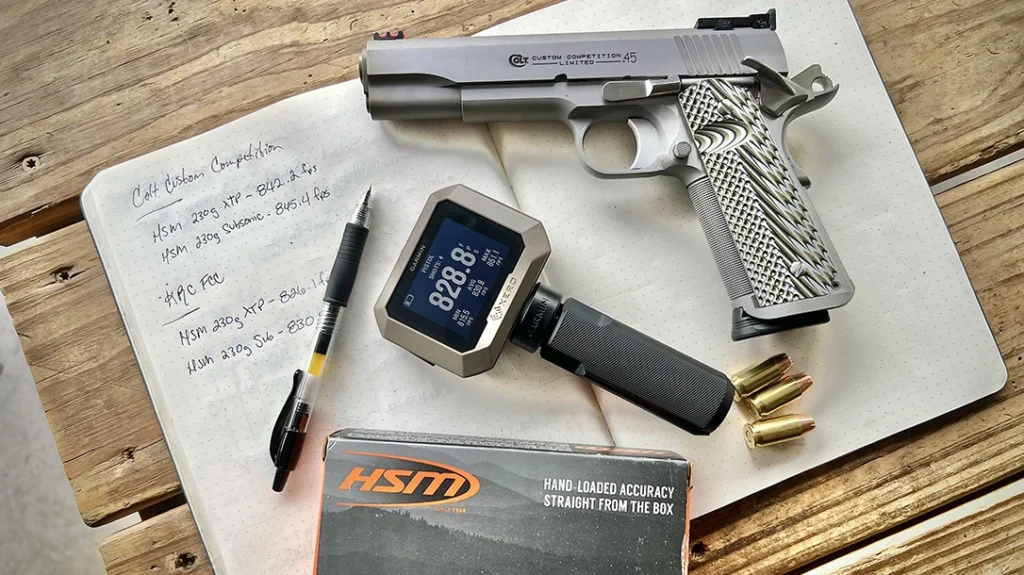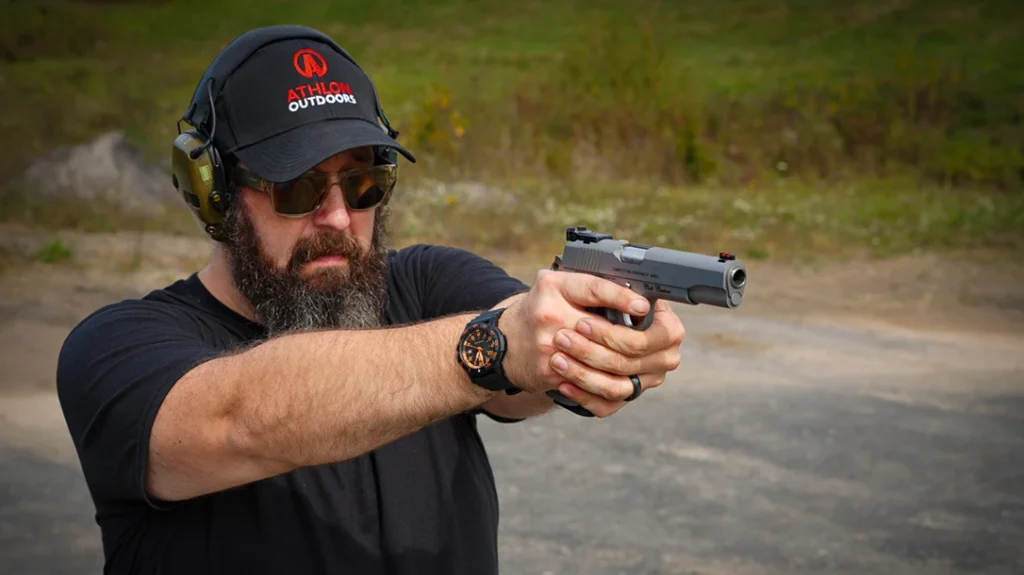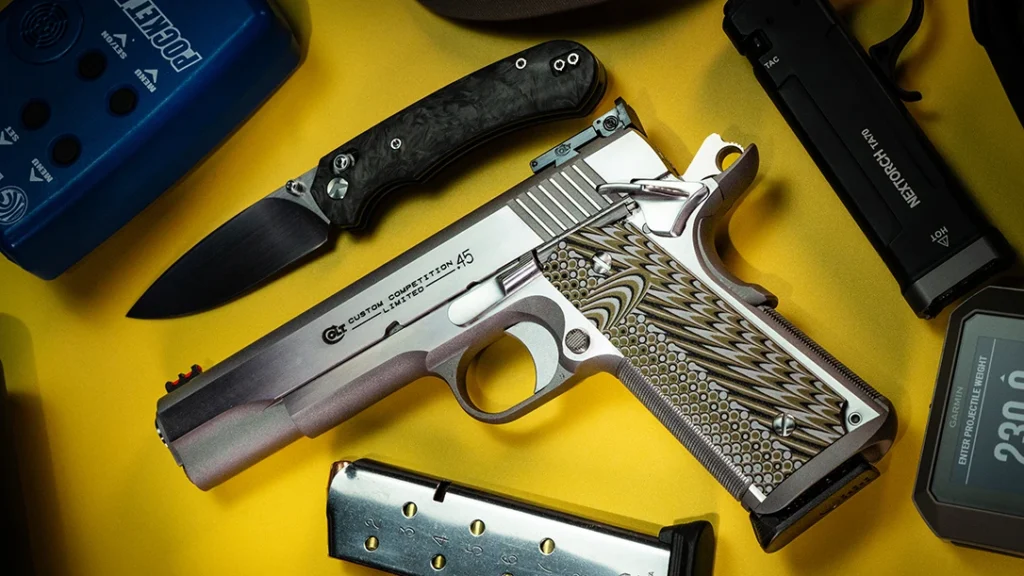The Colt 1911 is more than a familiar silhouette in steel. It is the clearest through-line from the dawn of modern service pistols to today’s match guns, and there is a reason so many makers have spent the last century iterating on John Moses Browning’s core blueprint. You can buy any number of interpretations, yet you can still buy the original from the company that fielded it first. When Colt’s Custom Shop builds a competition gun, the question is not whether the platform can still run with the best. The question is how close a factory gun can come to a tuned single-stack built the slow way for one shooter. That is what I set out to learn with Colt’s Custom Competition model in .45 ACP.
Colt’s Custom Competition Origin & Architecture
Browning’s 1911 was the culmination of a decade of locked-breech, short-recoil work through the Colt 1900, 1902, 1905, and 1907 patterns, paired with the Army’s call for a .45 caliber service round that became .45 ACP. After brutal trials that punished designs in mud, dust, and volume, Browning’s pistol won on reliability, controllability, and serviceability. The tilting barrel, swinging link, vertical locking lugs, and straight-forward control layout he fixed in place are still the scaffolding under most modern service pistols. It is useful context because the Colt Custom Competition is not a departure from that DNA. It is a careful refinement of it.
What Colt Built
This is a stainless gun front to back, with a forged slide and forged frame, bead blasted across the inside, with major flats polished, a glare-cutting surface with an attractive shine. The top of the slide wears five rounded anti-glare serrations, with a BoMar-style blacked-out rear and a fiber-optic front. That sight picture is my favorite for speed and accountability on a bright range. It is not a carry set, and that is fine, because this pistol’s job is winning drills and printing tight groups.
Advertisement — Continue Reading Below
Controls are spec’d for work. The thumb safety is larger than a GI paddle, which makes for confident, repeatable sweeps on presentation. The magazine release uses a lighter spring that speeds reloads without falling out in the holster or under recoil. The controls and grips screwsare polished stainless, a choice that gives a little visual lift and a touch of slickness under the thumb.
Inside the slide sits a stainless National Match barrel and a properly fitted bushing that needs a wrench but does not gall the slide during takedown. The barrel feet are cut to the frame’s vertical impact surface with the kind of even contact that keeps timing stable. Up top, the three locking lugs on the barrel engage their corresponding recesses in the slide, and on the sample I tested all three were sharing load with zero end-shake after the first hundred rounds. That is how you buy accuracy and service life at the same time.
Advertisement — Continue Reading Below
Way The Colt Runs
Colt uses a dual recoil spring on this model. Together they net about 17 pounds of closing force. A recoil spring’s job is to return the slide to battery and it technically needs only a fraction of its nominal value to do that on a clean, cool pistol. The benefit of a nested or dual spring system shows up at the ends of travel. The gun gets a consistent deceleration at the back, then an assertive return to battery when things are hot, dirty, and moving quickly. On the range that feels like a smooth recoil impulse and a decisive close.
Colt’s Custom Competition Fit
This pistol is not bank-vault tight between the rails, and that is intentional. The sample I measured showed about five thousandths of running clearance. A little daylight between slide and frame keeps a working 1911 reliable when expansion, fouling, and imperfect lube show up. Accuracy on a 1911 lives more in the bushing, hood, and lug timing than in rail drag. A slide that cycles without sticking and a barrel that locks the same way every time will shoot tiny groups without choking when the gun heats up.
Parts your Hands Live On
Colt fitted a solid, rounded trigger of standard width, not the wide Gold Cup shoe, with a properly adjusted over-travel stop (hidden inside the trigger itself). The hammer is a ring pattern that clears gear and looks right on a competition Colt. The front strap is undercut at the trigger guard and sharply checkered at 25 lines per inch. The mainspring housing and magwell wear matching 25 LPI texture. The funnel itself looks very much like a Stan Chen style unit. It inhales magazines at speed without pinching palms.
Advertisement — Continue Reading Below

Grips are VZ Operator II panels, aggressive enough for control in sweat and dust. If you are shooting day-long courses of fire, you may want to tune that texture to taste, and VZ makes a dozen patterns that drop straight on. The result is a frame that locks into the hand high, straight, and repeatable. It is easy to keep the sights in the same vertical channel through the press.
Magazines that Actually Help
I rarely write many words about a factory magazine, but this one deserves them. The supplied magazine uses a steel follower with a projecting tab that rides in the tube, a retention nub that keeps the follower feeding until the last round, and a radiused base pad that is anchored by a stainless pin. I have run a lot of 1911 magazines that were fine until they were not. The one that arrived with this Colt is easily among the best factory mags I have used. My understanding is that Checkmate builds it for Colt under contract, and whoever signed off on that spec did shooters a favor.
Advertisement — Continue Reading Below
How It Shoots
Group size data from handguns is often misleading without a rigid protocol. Variables pile up fast. That said, this gun should shoot better than ordinary. With three .45 ACP loads from HSM, the best string of the day was a two-inch five-shot group at fifty feet using their slower XTP hollow point. That is among the better groups I have shot with all the factory 1911’s I’ve tested. The trigger averaged two pounds nine point seven ounces on my Lyman gauge across multiple presses, clean break, minimal movement after the shot. The front sight lifts, the dot of color floats, and the gun returns predictably. You can run fast singles on a USPSA target and never feel like the trigger is dragging you out of the A-Zone.

Velocity of ammo tested:
- HSM 230g XTP – 842.2 fps (Best Group)
- HSM 230g Subsonic – 845.4 fps
Recoil impulse is classic big-bore single-stack. The dual spring system gives a cushioned roll, then the slide closes with authority that feels more like a tuned hardball gun than a loose service pistol. The checkering does its job without chewing. The safety clicks on and off with a positive detent, though On is much stiffer than Off. This may take a moment to get used to for someone new to the Colt Custom guns. The magazine release is light enough that long strings of reloads do not fatigue.
Advertisement — Continue Reading Below
Reliability
Across the first ~200 rounds, I had two early failures to fire where the hammer stopped at half-cock. I tried to replicate it with dry cycling and live fire and couldn’t; the gun then ran normally through the rest of that session and the next. On a new 1911 this can be tolerance stack, a brief sear/disconnector hiccup, or a thumb riding the safety. Since it didn’t recur, I’m logging it as-is; if it returns, I’ll check sear-spring tension and safety fit.

Plenty here for someone who actually runs a gun. Forged slide/frame with clean edge breaks, consistent machining, correct barrel fit, and lug timing that shares load across all three upper lugs. Bushing is snug without drama. Thumb safety is properly sized. Front-strap checkering and magwell are clean and matched. Magazine quality is excellent. In short, the core 1911 relationships for accuracy and reliability were respected.
Advertisement — Continue Reading Below
Changes
These are preferences, not defects. First, no forward cocking serrations; if you rely on them for press checks, you’ll miss them. This is the only Custom Shop gun I can remember that doesn’t have them… Second, I’d prefer a thicker, flush-cut bushing face at the muzzle for a more purposeful look (though that maybe nit-picky). Third, stainless is great for longevity, but a PVD/Melanite option would be welcome in 2025.
The Price that Matters
MSRP is $2,500. Street price on low-volume Custom Shop guns can float with supply. Stack this build against a $1,000 base 1911, then add the machine time and hand work to fit a National Match barrel/bushing, time lugs, undercut and checker the frame, fit a quality magwell, install/zero a BoMar-pattern rear with a fiber front, and tune a crisp sub-3-lb trigger that still passes safety checks; you’ll exceed this MSRP at most custom benches. The value isn’t “cheap”; it’s paying for correct work where it matters, from the original maker, without a year-long wait.
Living with Colt’s Custom Competition .45 ACP
Beyond groups and parts lists, the pistol wants to be shot. The undercut lets the strong hand ride high without fighting the middle finger; 25 LPI gives traction without rasping over long strings. VZ panels let you choose bite. The safety lands under the thumb, the slide tracks cleanly, it feeds wide hollow points as easily as ball, magazines eject decisively, and the magwell forgives less-than-perfect reloads. After a few strings it’s obvious the geometry is right and refined.
Advertisement — Continue Reading Below

Final Shots
The Colt Custom Competition in .45 ACP is exactly what its name implies. It is a factory competition gun that honors the mechanical truths that make a 1911 accurate and dependable. Forged slide and frame, correct barrel fit, real checkering, a smart magwell, a sight picture that balances speed and precision, a crisp trigger that breaks at two pounds and change, and two shipped magazines that cooperate rather than compromise the system. My sample had two early half-cock events that did not repeat. I am recording that for transparency and moving on, because the rest of the cycle was uneventful in the best way.
And, I would like front serrations and a flush-face bushing for both function and style. I would happily order this pistol at the stated MSRP. If you want a stainless Colt that feels like Colt is putting its best foot forward for shooters who actually shoot, this is that gun. It represents the original maker doing the original design the right way in 2025, with an honest nod to match work and no apology for being purpose built.
Advertisement — Continue Reading Below
If you have been waiting to buy a 1911 that gives you the vintage feel with modern manufacturing and a spec that makes sense for the range, check Colt’s current Custom Shop catalog and be ready to move when one lands. The queue can be a few months. The shooting is worth it.
